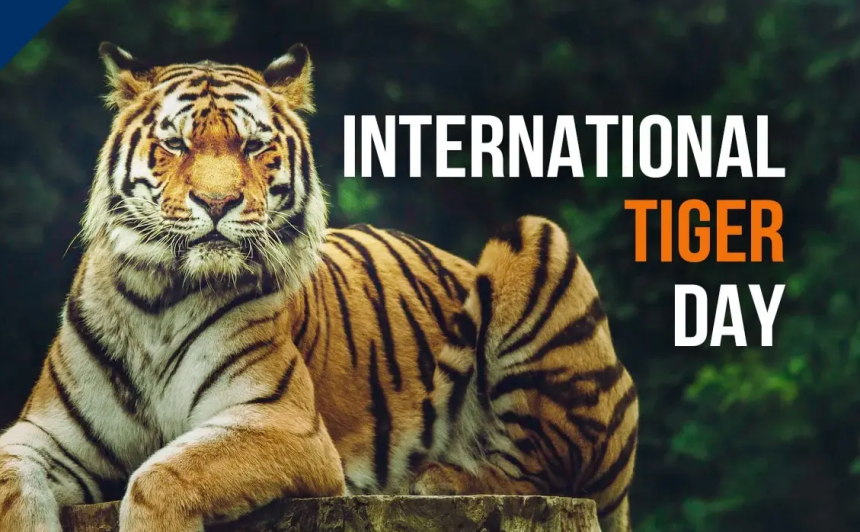Bison Cum Tiger Interpretation Center (Pachmari): Marking up International Tiger’s Day
The date of 29th July every year keeps a tryst with the yellow striped feline belonging to the species of ‘Panthera Tigris’ or Tiger

By Colonel Satish Singh Lalotra
INTERNATIONAL TIGER’S DAY
The central India of our sub-continent has a unique positioning in terms of interconnecting various hot-spots, be they of any nature ranging from diverse cultures to bio-diversity of the ‘Western ghats to that of the NE regions of India. Nowhere else in this entire country of ours will we find a geographical area( Madhya Pradesh) that is affording contiguity to such diverse races of both people, flora & fauna as that prevailing in our far eastern region to that of its mainstream areas as found obtained elsewhere in the country. The state of MP has great biological diversity which includes the diversity of ecosystems including plateaus, ravines, ridges, valleys and flat plains.
Madhya Pradesh has one of the richest faunal and floral diversity comprising of about 5000 plant species, 500 bird species and 180 fish species. The agro-diversity includes thousands of rice cultivators, a diversity of minor millets, indigenous cattle and poultry such as ‘Kadaknath’ chicken etc. to name a few. The place is home to six (6) tribes with distinct customs and practices plus diverse cultures to boot. MP is also home to one of the largest and most diverse national parks and tiger sanctuaries aka ‘Tiger reserves’.
The date of 29th July every year keeps a tryst with the yellow striped feline belonging to the species of ‘Panthera Tigris’ or Tiger. Belonging to the ‘charismatic mega fauna’ –a class of animals that are large –in the relevant category that they represent –with symbolic value or widespread popular appeal ,these felines are often used by the environmental activists to gain public support for environmental goals. Tiger is one such ‘mega fauna’ that has had the ability to reign supreme on the mental firmament of we Indians since India happens to be home to about 70% of world’s tiger population . Global tiger day is celebrated every year on 29th of July as a way to preserve and raise awareness about this magnificent but endangered big cat. The day was founded in 2010, when the 13 ‘tiger range countries’ came together to create TX-2 (global goal to double tiger population by the year 2022) at St Petersburg in Russia.
At the time of inception of this ambitious project more than 14 years back, tiger population was reckoned to be about 3000 with the shocked revelation that about 97% of world tigers had vanished from the face of the earth owing to reasons that were partially natural and most of them man made. .Since a national park or a sanctuary is the window of opening for the flora and fauna of a particular region that is visited upon by millions of travellers as well as nature aficionados, there is a need to put all these natural gifts under one roof for a visitor to show case all the assets with their suitable interpretative meanings for the ease of understanding and assimilation.
Moreover since the vastness of a national park or a forest sanctuary precludes a hard-pressed visitor to touch all important places in one go, it is here that these interpretative centers come into play and bridge the gap between places left untouched and those visited in a national park or a forest sanctuary. The interpretative center takes along with it all modern ways of communication both audio and video , charts, models , photographs , mannequins and such like aids to help a visitor get the hang of the place as soon as possible.
In addition to the above an interpretative center helps retain the values and beliefs for the community and preserve, promote, and undertake plus understand the cultural heritage, beliefs and the surrounding environment which in this case could be a national park or a forest sanctuary. They also serve educational, community –building, research and tourism while fostering cultural diversity, identity and pride. Shall dwell upon this Bison cum tiger interpretation center a little later after having laid bare some very startling facts on this international tiger’s day of 2024.
As a throwback to the ‘TX-2’ Initiative taken by the 13 tiger range countries I have taken few examples that would throw much light on this national animal of India and its condition worldwide. Nepal one of the signatories to this famed TX-2 programme had 355 wild tigers till as late as last year, up from the figure of 121 from the cut off year of 2010. Switching on to Bhutan another signatory to this ambitious project , this Himalayan monarchy has about 150 wild tigers up from a modest figure of 95 as recorded from its base year of 2010.
The ‘Royal Manas national park’ is at the forefront of tiger conservation which had a meager 10 wild tigers in its precincts swelling to 22 between 2010 to 2016 and thereafter to the above final figure of 150 till as late as last year. Coming to Indonesia, the extinction of wild tigers from Java and Bali in the past century has resulted into this beast finding solace on the island of Sumatra. With less than 400 wild tigers left in that island and the IUCN (International union of conservation of nature) classifying them as critically endangered, urgent action is the need of the hour.
Malaysia’s wild tigers are critically endangered too with as few as 250 only remaining owing to poaching, habitat loss, forest degradation and fragmentation. Malayan tiger too now finds its fortunes tagged to the red list of IUCN which has put a caveat to Malaysia to get its act together for tiger conservation. Representing 76% of total world population, south Asia with some of the countries as mentioned by me including India has been the mainstay of this striped beast. Finally the last bastion of this striped beast- India; we have always been the ‘Standard bearer’ for taking this striped beast to its next level. From recognizing this animal as the national animal of India way back in 1973 , to launching ‘Project tiger’ in the same year (one of the biggest tiger conservation programmes in the world) this majestic carnivore can’t find a better place than India for its survival on this planet.
In line with the above thought process, MP has some of the most elaborative and eye opening interpretative centers based in some of their tiger reserves. One such marvelous interpretative center that has its abode with in the precincts of ‘Satpura tiger reserve’ aka ‘Madhai tiger reserve’ near Pachmari goes by the name of ‘Bison lodge museum ‘ or Bison cum tiger interpretation center. I have had the wonderful opportunity, time as well as inclination to visit this excellent interpretation center way back in 2011 when I had gone with family to Pachmari from CPE Itarsi. Incidentally ‘Bison cum tiger interpretation ’ center is also laced with a historical background that dates back to the mid-19th century of British India. It holds the double distinction of being the oldest house constructed in Pachmari by our colonial masters during their occupational period.
Built by one Capt James Forsyth of Royal Bengal lancers forming part of British Indian army it has its origins shrouded in both bravery and mystery. Capt Forsyth had come on an official assignment over here in the year 1862 to carry out survey and exploration of the forest areas as directed by his superiors. During one of those official assignments in the forests of Pachmari he was charged upon by a raging bison (Indian Gaur) whom he had to kill in self-defense. The spot where this shoot out took place in self-defense has now the ‘wonderful Bison interpretation center’ in all its glory. This oldest colonial building was converted into a museum cum interpretation center in 1986 by India. It is now a ticketing and facilitation center of STR ( Satpura tiger reserve). It was the main headquarters of forest department of CP & Berar for more than half a century too before the reorganization of Indian states took place as part of overall rationalization of Indian states which are now visible to us in the political map of India. In addition to the above Capt James Forsyth had left his imprints in the form of ‘Forsyth point’ which is now called as the ‘Priyadarshini point’. This particular point is situated in compartment number 301 of the Pachmari sanctuary.
There is a legend which goes with Capt James Forsyth that says he was headed to Jhansi in the wake of 1857 uprising with his troops when he took fancy to this quaint place and decided to settle down here after his military engagement. But this appears to be slightly far-fetched, since there are evidences enough of this gentleman having come to Pachmari for carrying out the forest survey for finally making a blue print of a British garrison over here. Bison cum tiger interpretation center has been developed by CEE ( Center for environment education) Ahmedabad and boasts of a wide array of hay stuffed wild animals like tigers, leopards, panthers, Bisons, crocodiles etc. crouching or crawling in various postures, with their hides & horns all in an excellent condition .
The center has showcases that display exhibits of pictures, models, maps, graphs, and samples of local flora in all their splendor too. It has a huge audio-video open air hall that screens short movies / clips and documentaries as well as presentations on wildlife which transports back a visitor to the innermost recesses of this sanctuary bringing him back to the present with all its attendant details. The entry ticket for Bison cum tiger interpretation center is modestly priced at Rs 660/ per person without guide and Rs 960/ with guide. This ticket is all inclusive of entry fee for the Bison cum tiger interpretation center, Satpura national park, Bee falls, Dutchess fall, Reeechgarh, Astachal Ramya kund and many more such places of interest. I had made entry to this Bison cum tiger interpretation lodge from ‘Madhai tiger reserve’ or Satpura tiger reserve via Madhai gate having crossed the Tawa river on a streamer and thereafter came to Pachmari eventually landing at this excellent spot.
In fitness of things, before a tourist or traveller heads towards this Bison cum tiger interpretation center it would be prudent to find out the availability of jeeps that are a must for taking him or her into the various places of tourist interest that are strung astride the roads of Pachmari tiger reserve aka ‘Satpura tiger reserve. Since personal cars are not allowed inside the area, it would save much time and effort on the part of the visitors to be armed with such information to make arrangements accordingly. Bison cum tiger interpretation center has long been the standard bearer of show casing the jewels of forest wealth of central India, in particular of Sapura mountain ranges & still continues to do so in all its wonderful exposition. It’s a ‘must visit’ on the itinerary of an avid traveller or visitor going into these mountain cum forest ranges that divides India geographically into two equal halves.
(The writer is a regular scribe of RK and can be approached on his email—slalotra4729@gmail.com)



